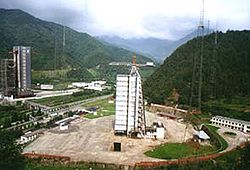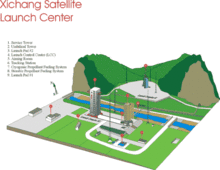Xichang Satellite Launch Center
| Xichang Satellite Launch Center | |
|---|---|
西昌卫星发射中心 | |
 Xichang Satellite Launch Center | |
| Alternative names | Base 27 |
| General information | |
| Location | Xichang, Liangshan, Sichuan |
| Coordinates | 28°14′45.66″N 102°1′35.60″E / 28.2460167°N 102.0265556°E |
| Opened | 1984 |
| Xichang Satellite Launch Center | |||||||
|---|---|---|---|---|---|---|---|
 | |||||||
| Simplified Chinese | 西昌卫星发射中心 | ||||||
| Traditional Chinese | 西昌衛星發射中心 | ||||||
| |||||||
The Xichang Satellite Launch Center (XSLC), also known as the Xichang Space Center, is a People's Republic of China space vehicle launch facility (spaceport) approximately 64 kilometres (40 miles) northwest of Xichang, Liangshan Yi Autonomous Prefecture in Sichuan.
The facility became operational in 1984 and is primarily used to launch powerful thrust rockets and geostationary communications and weather satellites. It is notable as the site of Sino-European space cooperation, with the launch of the first of two Double Star scientific satellites in December 2003. Chinese officials have indicated interest in conducting additional international satellite launches from XSLC.[1]
In 1996, a fatal accident occurred when the rocket carrying the Intelsat 708 satellite failed on launch from the Xichang Satellite Launch Center. Also, a 2007 test of an anti-satellite missile occurred from the center.
History
China's first manned space program
In order to support the Chinese Project 714 manned space program in the 1960s, the construction of a new space center at Xichang in the Sichuan province was decided, located farther from the Soviet border, thus safer. The Shuguang One spacecraft was expected to be launched from the launch pad number one. After the cancellation of the program the launch pad was never completed. Today a viewing platform for officials has been built at the site.[2]
First Long March-2E carrier rocket
China launched its first Long March-2E carrier rocket on July 16, 1990, sending into orbit Pakistan's first indigenously developed Badr-1 satellite and HS-601.
1996 Launch accident
On February 15, 1996 a fatal accident occurred when the first new Long March 3B heavy carrier rocket carrying Intelsat 708 veered off course 22 seconds after launch, crashing 1200 meters away from the launch pad in a nearby mountain village, destroying 80 homes. According to the official report, six people died and 56 were injured.[3] The number of civilian deaths has been disputed.[4]
China's first successful ASAT test
China conducted on January 11, 2007 an anti-satellite missile test with a SC-19 ASAT weapon.
A Chinese weather satellite—the FY-1C polar orbit satellite of the Fengyun series, at an altitude of 865 kilometres (537 mi), with a mass of 750 kg—was destroyed by a kinetic kill vehicle.
The SC-19 have been described as being based on a modified DF-21 ballistic missile or its commercial derivative, the KT-2 with a Kinetic Kill Vehicle and is fully mobile.
Beginning of China's lunar exploration program
On October 24, 2007, Chang'e 1, an un-manned Moon orbiter of the Chang'e program, was successfully launched from the facility, marking the beginning of China’s lunar exploration program.[5]
First Long March-3C carrier rocket
China launched its first Long March-3C carrier rocket on April 25, 2008. This was the 105th mission of China's Long March series of rockets, and also the launch of the nation's first data relay satellite (数据中继卫星) Tianlian I (天链一号).[6]
Future of the center
With the completion of the upgrade of Wenchang Satellite Launch Center scheduled for 2013, all the GEO missions will be transferred to this new space center. Due to negative aspects of the Xichang location, such as its higher latitude, the possibility of rocket stages falling on inhabited areas (Guizhou) and limited transport infrastructures, the Xichang Satellite Launch Center will no longer be used for civilian duties. However it will not be closed, it will be kept to serve as a backup launch site.[citation needed]
Facilities
Launch Complex 1 (LC-1)
Unbuilt Shuguang launch site, later used as a viewing area.[7]
Launch Complex 2 (LC-2)
Used for launching Long March 2E, Long March 3A, Long March 3B[8][9] and Long March 3C rockets.
Launch Complex 3 (LC-3)
Also known as LA-1. Used for launching Long March 2C, Long March 3, Long March 3A and Long March 3B rockets. Demolished and rebuilt between 2005 and 2006. Upgraded in order to support the Chinese Lunar Exploration Program.[10]Demolished and rebuilt again between 2013 and 2015.[failed verification]
Technical Center
XSLC's Technical Center is state of the art and is equipped for testing and integration of the payload and launch vehicle. Its Mission Command and Control Center is located 7 kilometres (4.3 mi) southwest of the launch pads, and provides flight and safety control during overall system rehearsal and launch. It is serviced by a dedicated railway and highway directly from Xichang Qingshan Airport, which is 50 km (31 mi) away from the launch site. Two launch complexes at the facility support flight operations.[11]
See also
- Chinese space program
- Jiuquan Satellite Launch Center
- Taiyuan Satellite Launch Center
- Wenchang Satellite Launch Center
References
- ^ "Dongfanghong IV ready for more int'l satellite orders". Xinhua News Agency. Archived from the original on October 2, 2008.
{{cite web}}: Unknown parameter|deadurl=ignored (|url-status=suggested) (help) - ^ "百人大厅静得能听见掉下一根针". Shanghai Morning Post. October 22, 2007. Retrieved November 20, 2007.[permanent dead link]
- ^ "96年火箭发射失控爆炸全过程". 大旗网. September 15, 2007. Retrieved June 13, 2008.[permanent dead link]
- ^ Anatoly Zak (February 2013). "Disaster at Xichang". Air & Space Magazine. Retrieved April 21, 2013.
{{cite web}}: Cite has empty unknown parameter:|coauthors=(help); Italic or bold markup not allowed in:|work=(help) (Article on the crash of a rocket carrying a commercial payload on February 15, 1996) - ^ "China's 1st moon orbiter enters Earth orbit". Xinhua News Agency. October 24, 2007. Retrieved October 24, 2007.
- ^ "我国首颗中继卫星发射成功 将测控神七飞行". 人民网. April 26, 2008. Retrieved April 27, 2008.
- ^ "Xichang Satellite Launch Centre". SinoDefence.com. Archived from the original on January 3, 2010. Retrieved March 7, 2010.
{{cite web}}: Unknown parameter|deadurl=ignored (|url-status=suggested) (help) - ^ "China launches French-built satellite". Xinhua News Agency. June 9, 2008.
- ^ "Long March 3B rocket launches Chinasat-9 satellite". Mister-Info.com.
- ^ "西昌卫星发射中心重建发射塔为登月作准备". 人民网. September 19, 2006. Retrieved June 11, 2008.
- ^ Profile of Xichang Satellite Launch Center, GlobalSecurity.org.
External links
- Aerial Maps from Google Maps
28°14′45.66″N 102°1′35.60″E / 28.2460167°N 102.0265556°E

